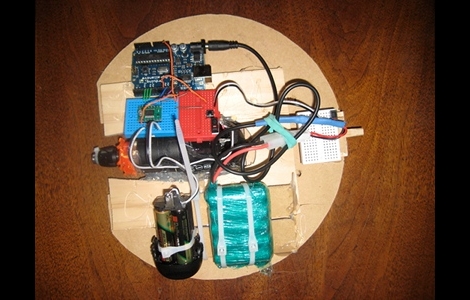
Hackaday forum member [machinelou] says he’s been fascinated with remote controlled hamster balls for quite some time. Inspired by a ball bot he saw on a BBC show, he finally picked up a 12″ plastic ball and got to work.
He used a small drill to provide the power required to roll the ball, and an Arduino is used as the brains of the device. This is his first major project outside of simple I/O and servo control, so he’s taking things slowly. While all this is a bit new to him, he already has things up and running to a degree as you can see in the video below. In its current state, the ball is programmed to roll forward and backwards for a few seconds before going back to sleep.
His future plans include adding a servo-controlled weight to allow him to steer the ball as well as using a pair of Zigbee modules in order to control the ball remotely.
It’s a neat little project, and definitely one that would be a fan favorite among kids. Stick around to see a quick video of his bot’s progress thus far.
[youtube=http://www.youtube.com/watch?v=Vuj8q_J-eRM&w=470]
















import SOUL
That is all…
http://xkcd.com/413/
What’s the theoretical maximum slope a ball bot can climb? Can it roll itself out of a sand trap?
Very cool project ;) I have a certain affinity for this one because I did the exact same thing 15 years ago using the same ball, except mine was blue. I started right away with the pendulum steering design and it was an instant A++ for my college senior project. The motor controller was made from scratch, except I didn’t have enough time to build in a custom controller solution. I just used a standard R/C radio system which worked well, and did some interface circuitry to massage the PMW from the receiver into an acceptable signal to drive the motor controller. It was a completely original concept to use the pendulum to steer the ball, but as it later turned out the technology was already patented back in like 1985, so I didn’t do anything with it. This same technology has been used by the military and NASA since then.
Looks nice … but seriously, 29 sec of video for 5 sec of actual movement?
I think the maximum slope it could sustain a climb up would be the greatest angle where some point on the surface of the sphere (where you have conveniently placed your pendulum weight) moves downward as the ball rolls. Once every point on the sphere is being lifted by the turning motion, there is no possibility of it being able to climb. Anyway, in the real world you probably wouldn’t get very close to that theoretical limit.
You could overcome that in the short term by rolling the ball against an internal ballast that is being used as a pivot.
Sorry, I only read the article after I posted that – I see this particular ball bot only uses the second method, so the answer is that the slope you can climb up is determined by how powerful the motor is and how much grip the ball has.